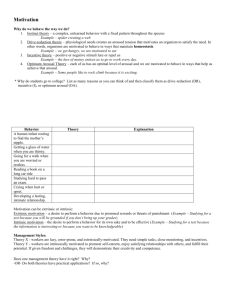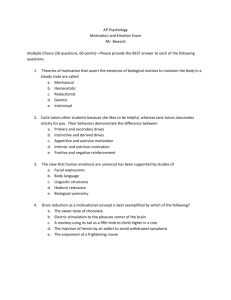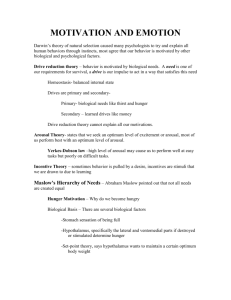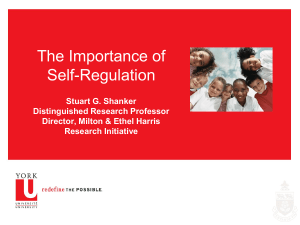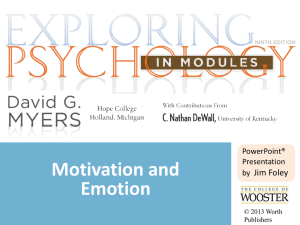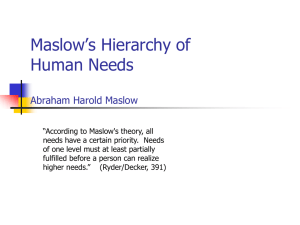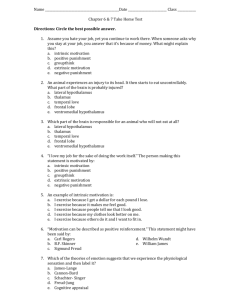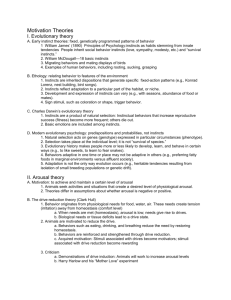Motivation Pop Quiz
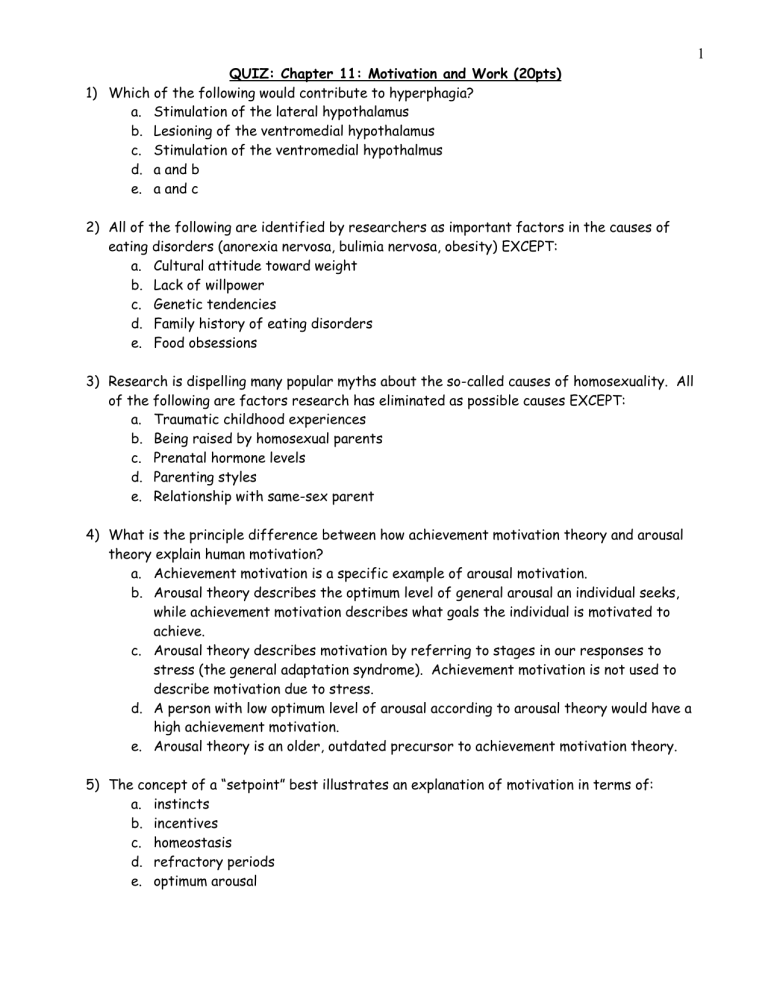
QUIZ: Chapter 11: Motivation and Work (20pts)
1) Which of the following would contribute to hyperphagia? a.
Stimulation of the lateral hypothalamus b.
Lesioning of the ventromedial hypothalamus c.
Stimulation of the ventromedial hypothalmus d.
a and b e.
a and c
2) All of the following are identified by researchers as important factors in the causes of eating disorders (anorexia nervosa, bulimia nervosa, obesity) EXCEPT: a.
Cultural attitude toward weight b.
Lack of willpower c.
Genetic tendencies d.
Family history of eating disorders e.
Food obsessions
3) Research is dispelling many popular myths about the so-called causes of homosexuality. All of the following are factors research has eliminated as possible causes EXCEPT: a.
Traumatic childhood experiences b.
Being raised by homosexual parents c.
Prenatal hormone levels d.
Parenting styles e.
Relationship with same-sex parent
4) What is the principle difference between how achievement motivation theory and arousal theory explain human motivation? a.
Achievement motivation is a specific example of arousal motivation. b.
Arousal theory describes the optimum level of general arousal an individual seeks, while achievement motivation describes what goals the individual is motivated to achieve. c.
Arousal theory describes motivation by referring to stages in our responses to stress (the general adaptation syndrome). Achievement motivation is not used to describe motivation due to stress. d.
A person with low optimum level of arousal according to arousal theory would have a high achievement motivation. e.
Arousal theory is an older, outdated precursor to achievement motivation theory.
5) The concept of a “setpoint” best illustrates an explanation of motivation in terms of: a.
instincts b.
incentives c.
homeostasis d.
refractory periods e.
optimum arousal
1
2
6) Which sentence more closely describes the difference between Theory X and Theory Y types of management? a.
Theory X managers are more active in work groups. Theory Y managers are more hands-off, letting groups work out problems on their own. b.
The management theories differ in regard to what tasks they delegate to workers. c.
Theory Y managers regard employees as more intrinsically motivated, while Theory X managers regard employees as more extrinsically motivated. d.
Management theory X is dominant in collectivist cultures. Theory Y is more prevalent in individualistic cultures. e.
Theory Y is used with workers who have high optimum levels of arousal. Theory X is used with those whose arousal levels are low.
7) How would drive reduction theory explain a person accepting a new job with a higher salary but that requires more work and responsibility? a.
Money is a more powerful incentive for this individual than free time. b.
This person seeks a higher activity level and takes the job in order to satisfy this drive. c.
For this person, money is a higher-level need than free time. d.
The person takes the job to satisfy the secondary drive of increased salary. e.
Humans instinctively seek greater resources and control over their environment.
8) The Garcia Effect describes: a.
the increased motivation felt by individuals with high levels of arousal. b.
the increased susceptibility to illness experienced in the plateau stage of the sexual response cycle. c.
classical conditioning associating nausea with food or drink. d.
the effect of a theory Y management style. e.
the effect the hypothalamus has on perceiving hunger.
9) Which of the following stages of Maters and Johnson’s Sexual Response Cycle do men and women show the greatest difference in duration? a.
Excitement b.
Plateau c.
Orgasm d.
Resolution
10) Which of the following is the correct order of Maslow’s hierarchy of needs, beginning with the bottom and continuing to the top? a.
Physiological, belonging, safety, esteem, self-actualization b.
Self-actualization, esteem, safety, belonging, physiological c.
Safety, physiological, esteem, belonging, self-actualization d.
Physiological, safety, belonging, esteem, self-actualization e.
Esteem, safety, belonging, self-actualization, physiological
3
11) Which of the following are reasons why intrinsic motivation might be more advantageous than extrinsic motivation? a.
Intrinsic motivation might be more enduring since extrinsic motivations are usually temporary. b.
Intrinsic motivations are easier and more convenient to provide. c.
Intrinsic motivations are higher on Maslow’s hierarchy of needs, so we are motivated to meet them before extrinsic needs. d.
Intrinsic motivations are more likely to be primary drives. Extrinsic motivations are secondary drives. e.
Intrinsic motivations are more effective with a wider range of individuals.
12) Which of the following is TRUE concerning Alfred Adler’s theory of birth order? a.
1 st born children are typically rated by their peers as more popular. b.
Presidents have historically been the youngest children in their families. c.
1 st borns tend to admire the past and be pessimistic about the future d.
Only children are extremely similar to the youngest children e.
All of the above are TRUE.
13) Simply the delicious sight and smell of a sizzling steak Lauren was served at Outback last night were likely to trigger an _________ in insulin levels in people like Lauren, who are identified as ________: a. decrease; internals b. increase; externals c. decrease; schizophrenic d. increase; highly intelligent
14) Which of the following words best relates to the arousal theory of motivation? a.
conservative b.
incentive c.
curious d.
practical e.
evolutionary
15) What organ is considered are most significant sex organ according to your book? a.
penis b.
vagina c.
testes d.
brain e.
none of the above
16) Even though Sarah routinely punches old ladies in the face, there was this one time that
Sarah helped an old lady cross the road. That old lady she helped cross the road just happened to be the interviewer at Sarah’s job interview, 2 years later, at Geico. The old lady couldn’t help but think Sarah was perfect for the job of head sales representative, so she hired her. The old lady was biased in her perception of Sarah because of the: a.
recency error b.
primacy effect c.
leniency error d.
halo error e.
Hawthorne effect
17) The goal of drive reduction theory is to achieve a balanced physiological state called: a.
equilibrium b.
homeostasis c.
self-actualization d.
the refractory period e.
set point
18) What brain structure governs the levels of sex hormones? a.
thalamus b.
hippocampus c.
hypothalamus d.
pons e.
reticular formation
19) People who identify as homosexual generally think of themselves as such ________ those who identify as bisexual. a.
before b.
after c.
at the same time as d.
a and b e.
None; heterosexuals are the only group that truly know their sexuality
4
20) True or false: our preferences for sweet and salty tastes are genetic and universal (shared by all humans)? a.
True b.
False
5
Chapter 11– Motivation Quiz – Answer Sheet
Name: ________________________ Block: ________ Date: ____________
1) ______________ 6) ______________ 11) ______________ 16) ______________
2) ______________ 7) ______________ 12) ______________ 17) ______________
3) ______________ 8) ______________ 13) ______________ 18) ______________
4) ______________ 9) ______________ 14) ______________ 19) ______________
5) ______________ 10) ______________ 15) ______________ 20) ______________
Bonus Questions on Back
Chapter 11 – Motivation Quiz – Answer Sheet
Name: ________________________ Block: ________ Date: ____________
1) ______________ 6) ______________ 11) ______________ 16) ______________
2) ______________ 7) ______________ 12) ______________ 17) ______________
3) ______________ 8) ______________ 13) ______________ 18) ______________
4) ______________ 9) ______________ 14) ______________ 19) ______________
5) ______________ 10) ______________ 15) ______________ 20) ______________
6
Bonus Questions on Back
Bonus:
1) Correctly identify (name) 1 of the cultures we discussed in class concerning global variations in sexual attitudes.
2) What was Vince Lombardi’s famous quote having to do with external motivation?
3) What was the Maslow’s Hierarchy acronym your class came up with?
4) What president (and first lady) commented about the sexual prowess of a rooster (and inherent differences btwn men and women) they saw while touring a farm?
5) In what two decades did Masters and Johnson do most of their research?
Bonus:
1) Correctly identify (name) 1 of the cultures we discussed in class concerning global variations in sexual attitudes.
2) What was Vince Lombardi’s famous quote having to do with external motivation?
3) What was the Maslow’s Hierarchy acronym your class came up with?
4) What president (and first lady) commented about the sexual prowess of a rooster (and inherent differences btwn men and women) they saw while touring a farm?
5) In what two decades did Masters and Johnson do most of their research?

